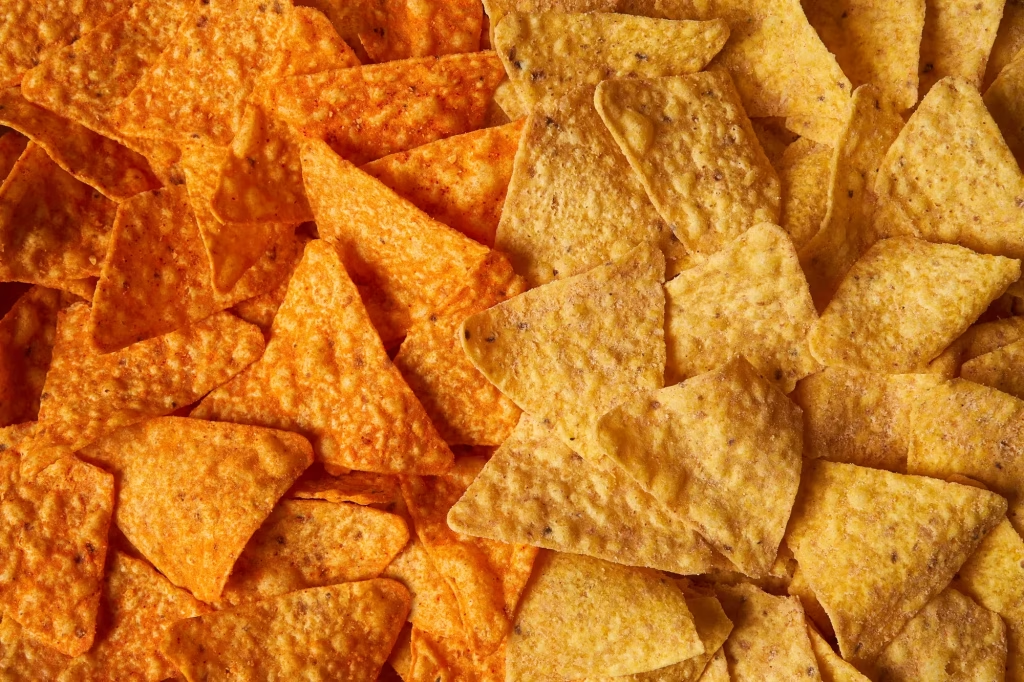
PepsiCo is taking two of its most recognizable snack brands “NKD”, stripping away artificial dyes and flavors in a major push toward cleaner ingredients. Beginning December 1, 2025, the new Simply NKD versions of Doritos and Cheetos aim to deliver the same signature crunch and flavor, but without the neon hues that defined them for decades.
This shift isn’t just a recipe update. It’s a strategic response to regulatory pressure, consumer expectations, and the rising demand for transparency in packaged foods. Here’s what the NKD transition means for the industry, and what brands should take away from PepsiCo’s move.
Why Is PepsiCo Taking Doritos and Cheetos “NKD” Now?
Short answer: Regulatory momentum + evolving consumer expectations.
Artificial dyes like Red 40, Yellow 5/6, and Blue 1 are under increasing scrutiny, with federal agencies reviewing safety data and signaling tighter future rules. At the same time, the clean-label movement has shifted from niche to mainstream, prompting consumers to favor shorter, more recognizable ingredient lists.
By introducing Simply NKD now, PepsiCo gets ahead of possible regulatory shifts and positions itself as a proactive leader, not a manufacturer forced into reactive reformulation.
What Actually Changes When Doritos and Cheetos Go Dye-Free?
Short answer: Less neon, fewer additives, same intended flavor.
Key differences
- No synthetic FD&C dyes
- No artificial flavors
- Removal of some flavor enhancers (e.g., disodium inosinate and guanylate)
- Shorter ingredient lists
- A visibly lighter chip color
What stays the same
PepsiCo stresses that the originals will remain on shelves, preserving customer choice and avoiding backlash from sudden recipe replacement. Blind taste tests reportedly found no meaningful flavor difference.

Does the NKD Strategy Strengthen or Risk Brand Loyalty?
Short answer: It’s a balanced risk, but one with long-term strategic upside.
Strengths
- Builds consumer trust through cleaner ingredients
- Reduces long-term compliance risk
- Reinforces PepsiCo’s leadership on transparency
- Attracts ingredient-conscious shoppers
Vulnerabilities
- Visual changes may reduce emotional attachment
- Some consumers may perceive flavor differences, real or imagined
- Natural alternatives often raise production costs
- Managing two formulas can complicate brand messaging
Still, by keeping the original formula intact, PepsiCo smartly avoids the “New Coke” problem.
How Do Dye-Free Formulas Impact Labeling Obligations?
Short answer: Reformulation triggers strict labeling, auditing, and consistency requirements.
1. Ingredient lists must be updated everywhere
Packaging, SmartLabel, retailer listings, ecommerce packaging, and distributor documents must all match. These inconsistencies are frequent grounds for class-action claims.
2. Claims like “no artificial colors” require rigorous substantiation
All suppliers must verify that:
- no synthetic dyes are used
- natural alternatives don’t create prohibited traces
- processing aids don’t contain disallowed colorants
Even small deviations can trigger litigation.
3. Clean-label language must be precise
Terms such as natural, simple, and clean carry no formal FDA definitions and are heavily litigated. If PepsiCo uses them, they must avoid implying greater health benefits than the formula supports.
4. Allergen and cross-contact risks must be reassessed
Natural coloring ingredients may introduce new allergen considerations, requiring updated hazard analyses.
What Marketing Pitfalls Should F&B Brands Expect With NKD Claims?
Short answer: “Cleaner” doesn’t mean “healthier,” and regulators are watching.
1. Avoid health halos
Removing dyes does not justify claims suggesting:
- improved nutrition
- better safety for children
- medical or behavioral benefits
These are common plaintiff angles in advertising suits.
2. Be cautious with side-by-side comparisons
If Simply NKD is positioned as the “better” version, this might imply that the original is inferior or unsafe, opening the door to false-advertising claims.
3. Don’t imply regulatory endorsement
Statements suggesting “aligned with future FDA standards” or “meets new requirements” can be considered misleading unless backed by published agency guidance.
4. Influencer posts count as advertising
If PepsiCo reposts influencer content overstating health benefits, the company inherits liability. This is a growing FTC enforcement area.

Does Going NKD Affect Packaging, Color Identity, or IP Protection?
Short answer: Yes, ingredient changes can influence trade dress, sensory marks, and trademark strategy.
1. Product color and appearance trademarks may require updates
If Cheetos’ iconic orange dust is lighter in the NKD version, PepsiCo must consider:
- whether the original color remains distinctive
- whether to register a new sensory mark
- how to prevent competitors from mimicking the new or original color
Appearance is part of brand identity in the snack sector.
2. Packaging redesigns impact trade dress protection
Clean-label aesthetics, minimalist visuals, softer palettes, natural imagery, may unintentionally weaken source-identifying elements. PepsiCo must ensure brand distinctiveness remains clear across variants.
3. Reformulation processes may be patentable
Transitioning to natural colors often requires:
- stabilization techniques
- flavor-preservation processes
- ingredient-encapsulation methods
If PepsiCo developed proprietary solutions, patent protection or trade-secret strategies may apply.
4. The Simply NKD sub-brand is its own trademark asset
This requires:
- domestic and international registration
- conflict checks (especially with “naked,” “nkd,” or “simple” marks)
- enforcement planning
- brand architecture mapping
Sub-brand clarity protects both the classic and NKD product lines.
What Can F&B Companies Learn From PepsiCo’s NKD Transition?
Short answer: Reformulation is a legal, branding, and regulatory event—not just a recipe update.
Key lessons:
- Audit labeling and claims before changes hit the shelf
- Align marketing, R&D, and legal early in reformulation planning
- Reevaluate trade dress, packaging, and sensory IP
- Document flavor testing and product-equivalence studies
- Prepare for consumer reaction, especially around appearance
Juris Law Group advises F&B companies on reformulation risk, labeling compliance, and brand/IP strategy when updating product formulas.
frequently asked questions (FAQs)
Are the original Doritos and Cheetos being replaced?
No, both versions will remain available.
Does dye-free mean healthier?
Not necessarily. The nutritional profile is similar.
Will Simply NKD look different?
Yes, the snack color will be lighter without synthetic dyes.
Can brands expect more dye-free reformulations across the industry?
Yes. Regulatory and consumer trends suggest more major food companies will follow.
What’s the biggest legal risk in these transitions?
Labeling and marketing claims that overstate benefits or imply regulatory approval.
Key Takeaway
PepsiCo’s NKD rollout shows how ingredient changes are now tied directly to brand reputation, regulatory exposure, and IP strategy. As scrutiny of artificial additives grows, brands should proactively review formulas, packaging claims, and trade dress protections before market pressure forces a change.
